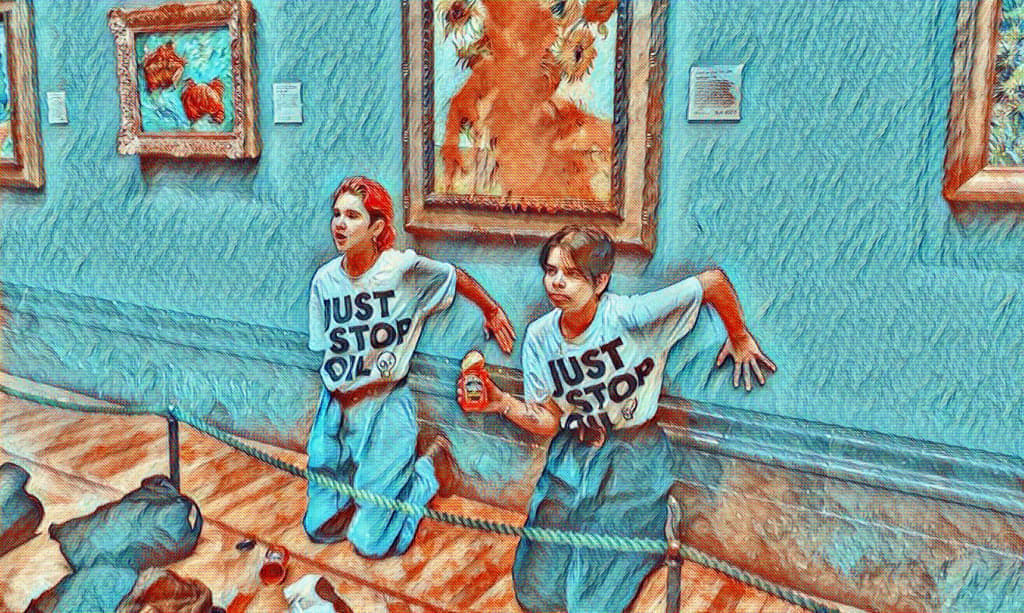The Climate religion already has its iconoclasts. Two planetary suffragettes attacked van Gogh’s Sunflowers, a painting at which they threw a Warholian can of tomato soup to the cry of “Why do you protect art and not the planet?” In this time of permanent performance, the two maenads of the Earth Goddess applied the only principle of their theology—ago quia ineptum est [I do what is stupid]—against a poor canvas whose relationship with the climatic apocalypse is more than doubtful. Given that, according to the most serious scientific hypotheses, it is the cows’ windy breath that is to blame for the agony of our atmosphere, wouldn’t it have been more purposeful, more dignified, more coherent to throw the red lump on some Paulus Potter, for example?
The very purpose of the action does not seem to have been the subject of long meditations, for neither is it very comprehensible that the preservation of art and the preservation of the planet are mutually exclusive ends. Burning five-pound bills at the door of the Bank of England or “tomatoing” Royal Dutch Shell executives, for example, would have had a greater cause-effect relationship, always within that complex system of sympathetic magic that is Woke activism. What does not seem very logical or symbolic is to attack in effigy some defenseless sunflowers, innocent children of Mother Earth. But coherence, logic, sensible analysis of the real and the adequacy of responses to disturbing facts are anathema to Woke subjectivity, macho qualities that surely offend the empowered Ojancanas of the climatic Moloch.
The action of these damsels is the necessary consequence of the kind of education given in Western schools, where instruction has long since become indoctrination, merit anathema, and seriousness and intellectual rigor crimes. Anyone who has had the dubious honor of contemplating the achievements of modern pedagogy knows that performance has become a daily liturgy, a curricular coven, a teaching jalogüín (Halloween) in all educational institutions, where earlier teachers, books, experience and reason explained the sciences and the arts to future professionals, scientists, humanists and technicians. But as now the institutes, lyceums and academies have as a fundamental purpose that the young people explore their trusses and not their brains, the stimuli of the active life are no longer in front of the weak but necessary barrier of the spirit, of the contemplative life, of the intellectual vocation. Therefore, what the iconoclasts of the National Gallery carried out was the application to external reality of what has been common practice in academic centers for decades: Dadaism.
The tomato wallops at van Gogh are the culmination of four decades of anti-elitist, anti-hierarchical, anti-class, anti-racist, anti-macho, avant-garde, inclusive, feminist, resilient, non-binary, trans-speciesist and other long etcetera of antis and -ists that the reader may wish to add. Anything but classical, humanist and scientific.
I have no doubt that these prophets of nihilism have far surpassed the great artist of our time, the woman who best represents the aspirations and achievements of contemporary man (with apologies): Marina Abramovic, who will have to invent something to surpass the two bacchantes of London. Only one superior sacrilege comes to mind: throwing tomato, or pineapple juice, or Coca-Cola or sulfuric acid on some “masterpiece” of Frida Kahlo, the best artist in history, eclipsed until our times by a phallocratic conspiracy of silence. It is true that van Gogh was a sort of hirsute, red-haired, disoriented and suicidal Frida, but with a better technique (which, on the other hand, was not very difficult, either). I think, moreover, that the tomato streaks should remain on the painting, as a sample of what we could call “Hysteric Art.” Worse things have been seen in many exhibitions and have been priced at gold-premium. The National Gallery must pay fair market value for their work to the two girls, since their “action painting,” in addition, has served to make their museum become a trending topic. And isn’t that the chief end of art?
What can bring a museum closer to the people than the opportunity to throw a tomato at the Mona Lisa? Wasn’t that what Duchamp, Jarry and Picabia advocated? Is there anything more interactive and inclusive, more accessible to everyone? Besides, the Planet will be grateful.
If there is one good thing about Woke “education” is that the most valued artists are Rothko, Pollock and Mondrian, not the devalued butches of Titian, Rubens or Rembrandt. Therefore, future tomatinas will not get to (in theory) the representatives of European pseudo art—Boucher, Renoir or Ingres who objectified the female body and who will soon be banished from museums for offending genderist curators as much as they used to offend the confessors of queens. It will be Juan Gris, Miró, Tàpies and other geniuses of our era who will receive the public tribute of the tomato-pelting. Besides, a crimson streak in their works will not be too noticeable, either: it will actually make them more material, more organic—authentic art of the masses, genuine aesthetics of democracy.
Sertorio lives, writes and thinks in Spain. this review comes through the kind courtesy of El Manifesto.
